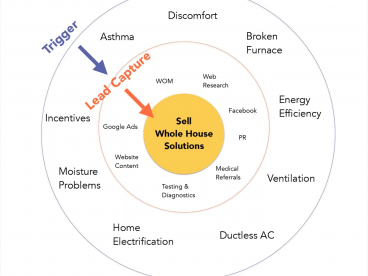
The opportunity for face-to-face, in-person sales consultations has vanished overnight for many contractors around the country, and companies are being forced to put more and more importance on the homeowner’s initial inquiry to convert leads and book jobs.
Virtually all initial inquiries are what we at Energy Circle call “the single measure lead,” or “the gateway concept,” where someone is calling up or reaching out with a particular issue they want to be resolved. No one calls looking for a whole home solution—they want a water heater replaced, or they have a cold room, or their kid is having asthma issues in their home, and it’s your job to find the actual underlying home performance issue.
Homeowner concerns start with a single trigger. Successful contractors pivot the homeowner mindset to system thinking and high impact, whole house jobs.
Where Are Initial Inquiries Coming From?
Gone are the binary lead days of getting just one or the other: a phone call or a website lead form. There are a variety of contact channels that prospective customers are now using to reach out to your business, including:
-
Lead Forms
-
Phone Calls
-
Live Chat on Website
-
Messages from Google
-
Messages from Facebook Messenger
-
Quote Requests from Google
-
Bid Requests from Aggregator (like Home Advisor)
-
Text Messages
Homeowners are reaching out differently than they used to, and they’re also expecting a faster response—data shows a growing demand for instant gratification.
Phone calls and live chat continue to grow in popularity and usage, while web form submissions are decreasing.
How to Overcome the Unique Challenges of That First Contact?
Energy Circle uses CallRail, a call tracking and call recording system for all of our clients. There have been over 600,000 recorded calls since 2012, and over 100,000 inquiries in 2019—80,000 recorded calls and 20,000 chat sessions or form submissions.
Using this enormous dataset, we’ve narrowed down five of the most common customer objections that a home performance contractor might encounter on that initial inquiry. Here’s what you can expect to hear from potential customers, as well as some advice on turning a challenging situation into a quality conversion.
#1: Asking for a Quote Over the Phone
One of the most common calls home performance contractors get are from homeowners looking for a quote over the phone.
A key tactic for shifting people away from this mindset is differentiating yourself from your competitors. Explain why you don’t give quotes over the phone: Companies that do aren’t as thorough as you are, and couldn’t possibly know things like how many penetrations need to be air sealed just through a phone call. Be direct, but remember: if someone is insistent, you always have the option of either giving them a rough estimate, or deciding that it’s not a lead worth pursuing.
Remember: not all calls or inquiries are necessarily good leads. You may not want to pursue someone who appears to be price shopping and will end up going with the cheapest company no matter what.
#2: The Self-Diagnosis
Often homeowners are experiencing an issue in their homes, and they call or reach out to you having already self-diagnosed the problem. How many times has someone called with concerns they’re wasting energy in their homes, and are certain that the primary problem is drafty windows?
Stubborn homeowners can be hard to course-correct, but emphasize your building science-based approach. Meet them halfway and acknowledge that their solution might be right, but that it’s in their best interests to go through your unique process of evaluation to most effectively solve the problem without exceeding their budget.
#3: Asking for a Specific Type of Insulation Only
“I’m just looking for a quote on [X kind of] insulation.”
Here’s another common inquiry—the homeowner who may be price-shopping, or may not be open-minded to your professional recommendations.
Emphasize the breadth of insulation options you use, explain the different considerations that go into choosing the correct material to address specific problems, and outline how you’ll be working with them to choose the right solution for their unique home problem.
#4: Asking for Insulation for a Specific Room
How about the homeowner who calls convinced that they need insulation, but just for one specific room in their home?
This is semi-related to a few of the previous objections we’ve mentioned, and could be a sign of self-diagnosis, or an indication that the homeowner has already gotten a recommendation or a quote from a competitor who’s visited the home.
It’s important to (gently) probe here to figure out how they arrived at their conclusion, and lean on your building science approach to explain why it will pay in the long run to be thorough and confidently identify the source of the problem.
#5: Doesn’t Want an Energy Audit
Many people call home performance companies, but don’t want to go through the process of a home energy audit. They might think they don’t need one, or don’t want to spend the extra money.
Depending on where your business is located, your diagnostic audit process could be very different. You may be in a state that has free or rebated energy audits, or have a policy where your audit prices are waived only if the homeowner decides to move forward with insulation work.
Emphasize the importance of a science based assessment. Cite examples where the audit changed the initial presumptive solution or even reduced the initial cost of the project, and lean on the value that having an audit done can have on the long term value of their home.
Be Smart, and Use Your Experience to Learn When to Walk Away
“I’ve tried all of your tactics, but some people just won’t have their minds changed.”
We get it—even the best salesperson or customer service rep isn’t going to be able to sway every single customer. This is a hard question to answer in a generic way, but knowing when to cut your losses can often depend on the size of your company and the sales strategy you have in place.
Some contractors can afford to take sales calls with a low hit rate. But if you own your own business and handle the sales side of things as well, your time is very precious and you may not want to spend your day on wild goose chases.
Ultimately, it will be up to you to use your intuition and experience to draw your own line in the sand, and learn how to identify when you’re speaking to a bad lead that will never convert, or when it’s worth your time to roll up your sleeves and lean on your expertise as a trusted home advisor to close the sale.
